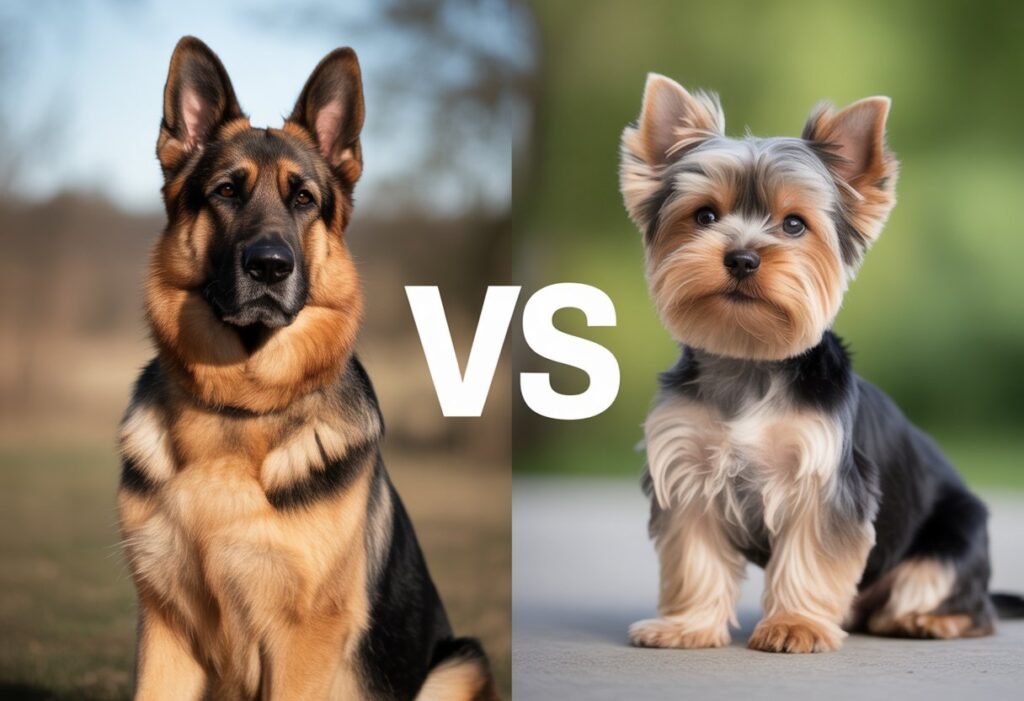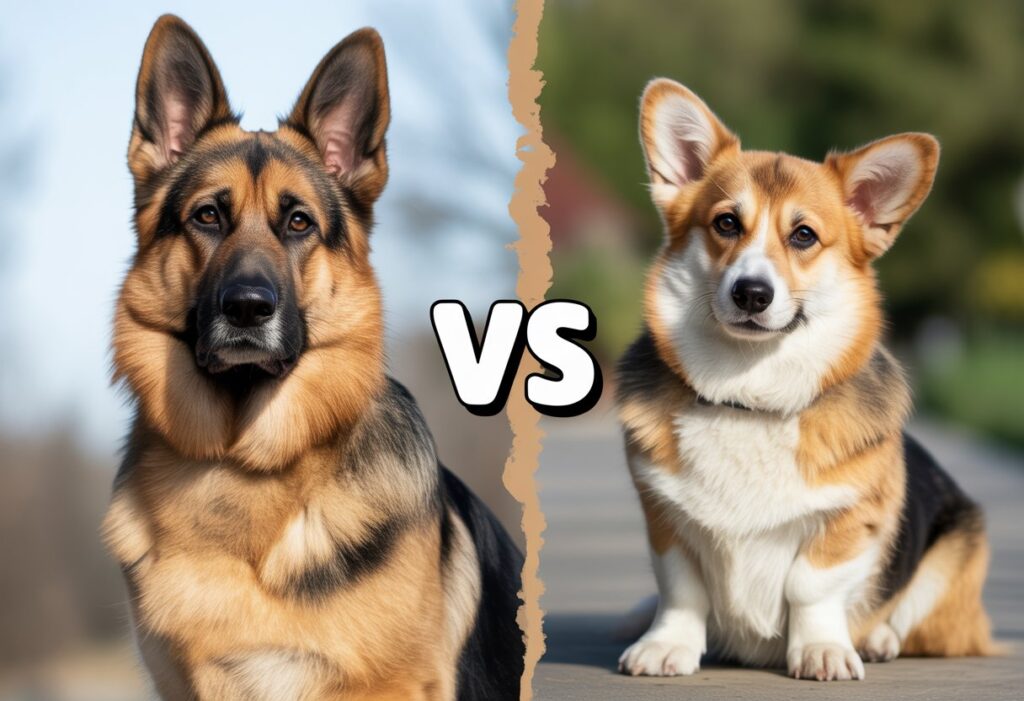Are you stuck between picking a German Shepherd or a Yorkshire Terrier? These two breeds couldn’t be more different, and choosing the right one really comes down to your lifestyle, home, and what you want from a dog.
German Shepherds are big, strong, and fiercely loyal. Yorkshire Terriers are tiny, bouncy, and love hanging out inside with their people.
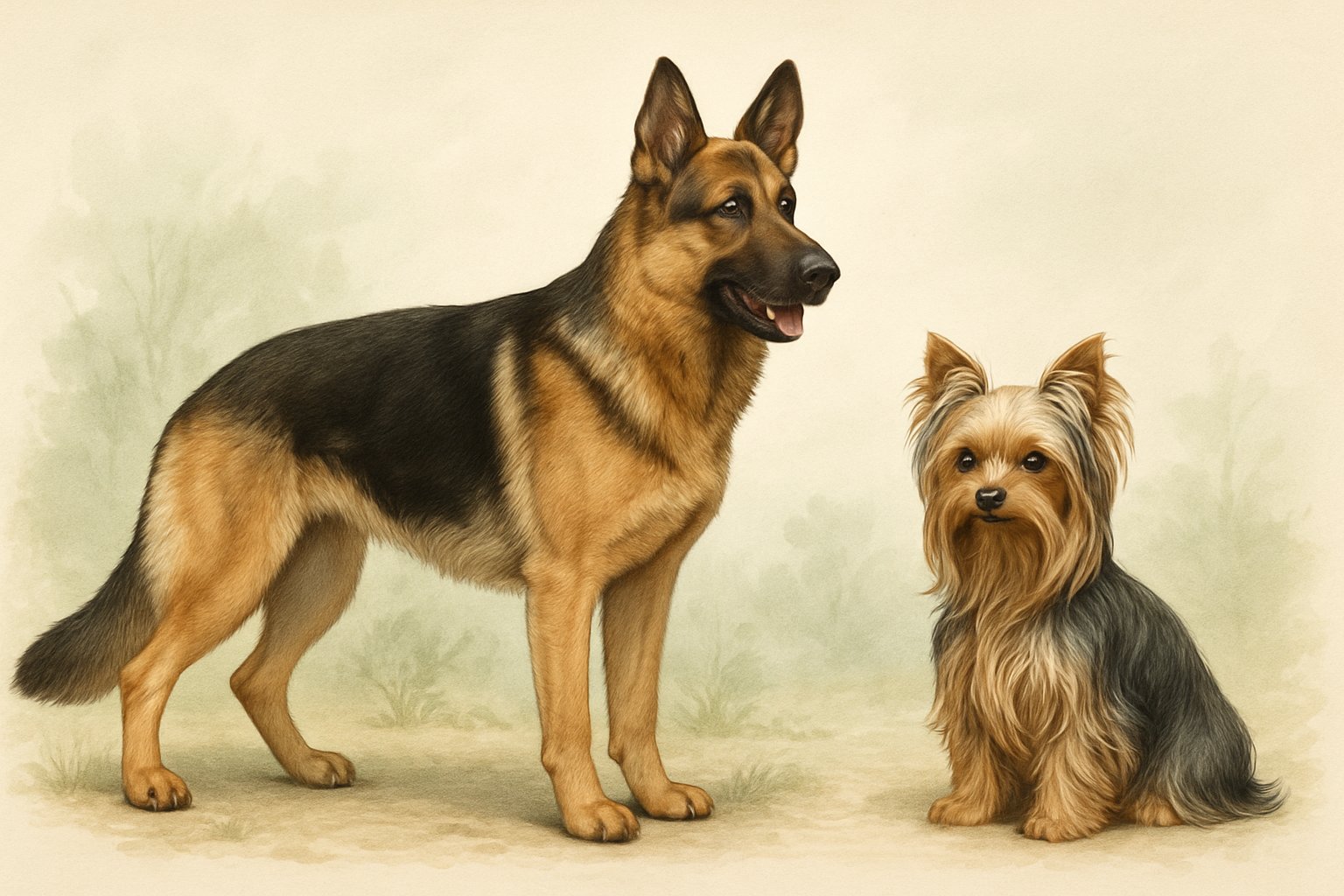
Both breeds bring something special to the table. It’s worth digging into their backgrounds, looks, personalities, and what it takes to care for them before making a decision.
Key Takeaways
- German Shepherds and Yorkshire Terriers come from very different backgrounds and have unique traits.
- Each breed has its own size, personality, and care requirements.
- The best fit depends on your lifestyle.
Origins and Breed History
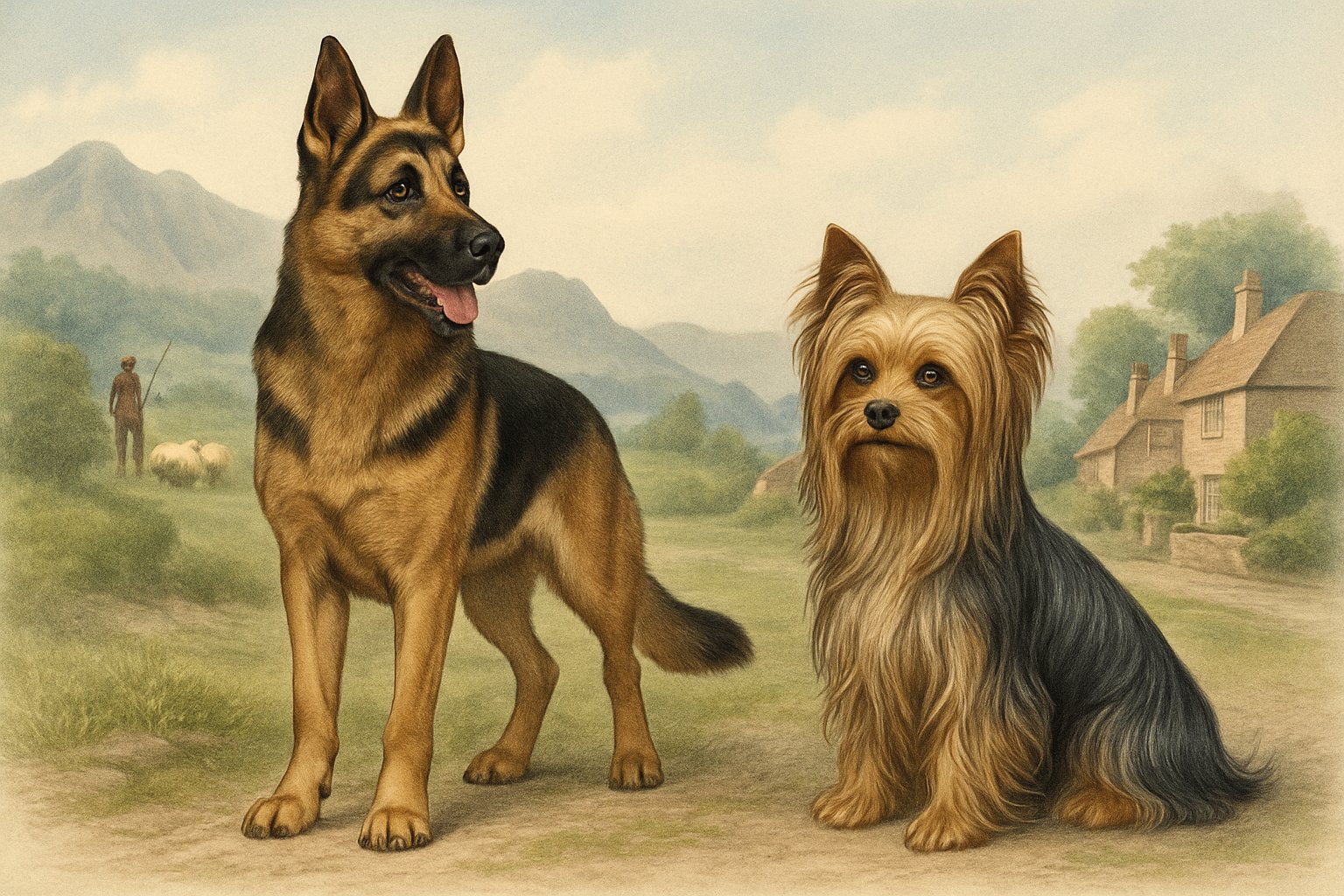
The German Shepherd and Yorkshire Terrier have roots that couldn’t be further apart. Each was bred for a specific purpose, which shaped how they look and act today.
The History of the German Shepherd
German Shepherds started out as working dogs in Germany in the late 1800s. Captain Max von Stephanitz wanted to create the ultimate herding dog, so he focused on intelligence, strength, and trainability.
At first, German Shepherds herded sheep on farms. Their skills soon caught the eye of police and military forces.
People started using German Shepherds for all sorts of jobs—guide dogs, service animals, search and rescue. They’re now one of the world’s most popular breeds.
The History of the Yorkshire Terrier
Yorkshire Terriers, or Yorkies, also date back to the 1800s, but up in northern England. Textile workers needed a small, tough dog to hunt rats and mice in mills.
They mixed several little terrier breeds, including the now-extinct Paisley and Clydesdale Terriers, to create the Yorkie.
Yorkies quickly became popular with wealthy families for their small size and silky coats. Their bold and friendly attitude made them stand out.
These days, Yorkies are mostly pampered companions. People love them for their playful spirit and adorable looks.
Parent Breeds and Ancestors
German Shepherds came from several types of European herding and farm dogs. Max von Stephanitz handpicked dogs with the best working skills.
Yorkies have a tangled family tree. Their ancestors include the Waterside Terrier, Skye Terrier, Maltese, and Paisley and Clydesdale Terriers. The Australian Silky Terrier shares some ancestry and often gets mixed up with Yorkies because they look so similar.
Here’s a quick rundown:
- German Shepherd: European herding dogs
- Yorkshire Terrier: Waterside Terrier, Paisley Terrier, Skye Terrier, Maltese, Clydesdale Terrier
Knowing their backgrounds helps explain why German Shepherds are smart and sturdy, while Yorkies are tiny, energetic, and charming.
Physical Characteristics and Appearance
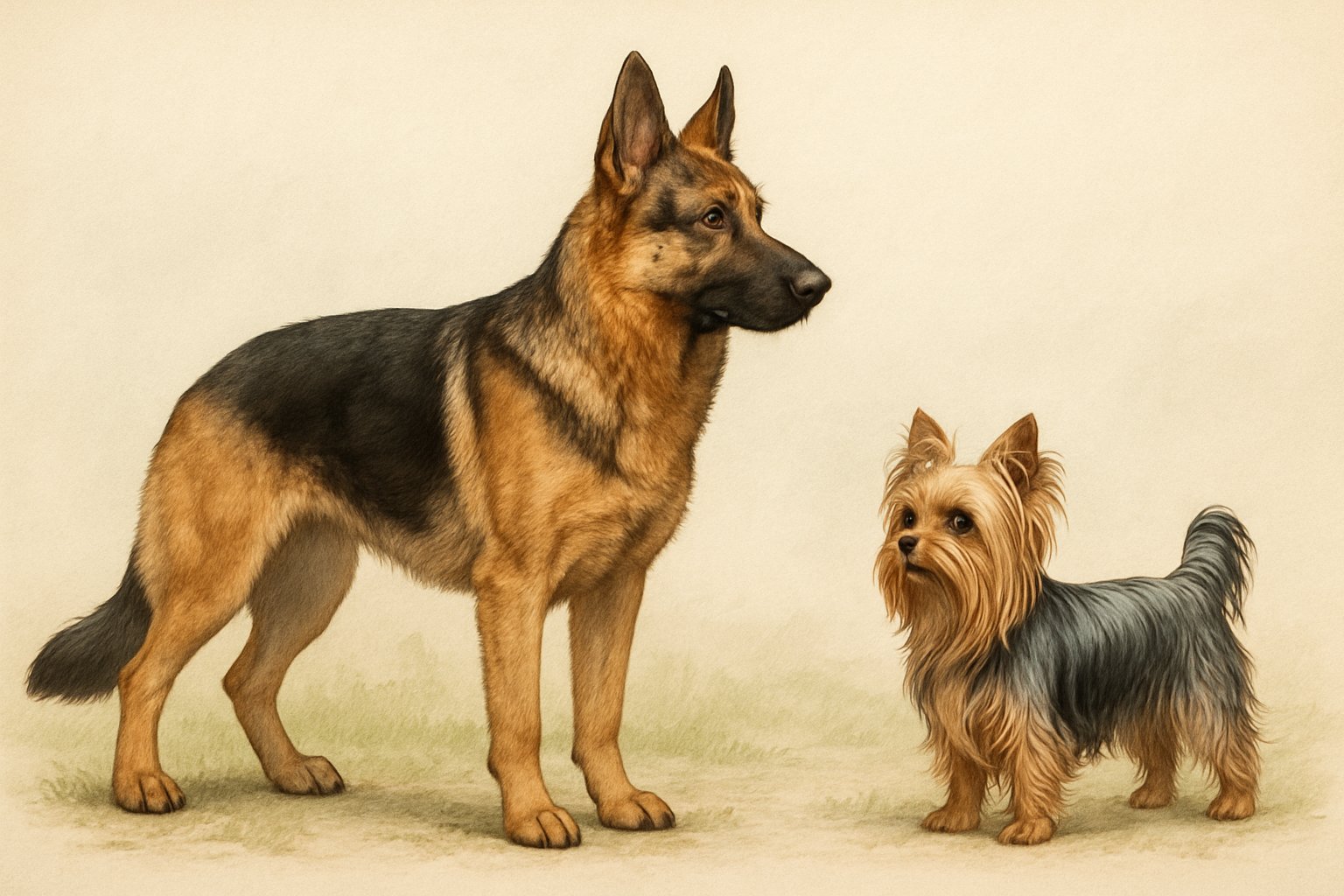
German Shepherds and Yorkshire Terriers couldn’t look more different. Their size, coats, and overall vibe set them apart.
Size and Build Comparison
| Breed | Height (inches) | Weight (pounds) |
|---|---|---|
| German Shepherd | 22–26 | 50–90 |
| Yorkshire Terrier | 7–8 | 4–7 |
German Shepherds are huge compared to Yorkies. They’re muscular and built for action, which makes them good for guard work or anything active.
Yorkies are tiny and light, perfect for apartments or city living. While both breeds have energy, the German Shepherd’s strength is obvious, and the Yorkie’s quick, nimble steps are hard to miss.
Compared to other small breeds like Toy Poodles, Maltese, or Shih Tzus, Yorkies are among the smallest out there.
Coat Types and Grooming Needs
German Shepherds have a thick double coat with straight outer fur. They shed all year, but it gets intense in spring and fall. You’ll need to brush them several times a week.
Yorkies have long, silky hair that just keeps growing. It looks gorgeous with regular brushing, but it tangles up fast if you skip grooming. Most Yorkie owners keep their coats trimmed short to make life easier.
Yorkies get compared to toy breeds like Maltese and Shih Tzus, who also need lots of brushing. The Toy Poodle’s curly hair needs regular clipping but doesn’t shed much. If you want a low-maintenance dog, Yorkies, Shih Tzus, and Maltese are at the high end for grooming needs.
Distinctive Features
German Shepherds stand out with their upright ears, long bushy tails, and alert, strong build. Their bodies look athletic, with a deep chest and sloped back. Most are black and tan, but you’ll see sable, black, or even white coats.
Yorkies have tiny frames, perky V-shaped ears, and silky blue-and-tan coats. Their round, dark eyes give them a lively, curious look.
Among small dogs, Yorkies are easy to spot thanks to their unique coloring and delicate build. Shih Tzus have flatter faces, Maltese are pure white with floppy ears, and Toy Poodles have a different body shape and curly hair. Every breed has something that makes it instantly recognizable.
Temperament and Personality Differences
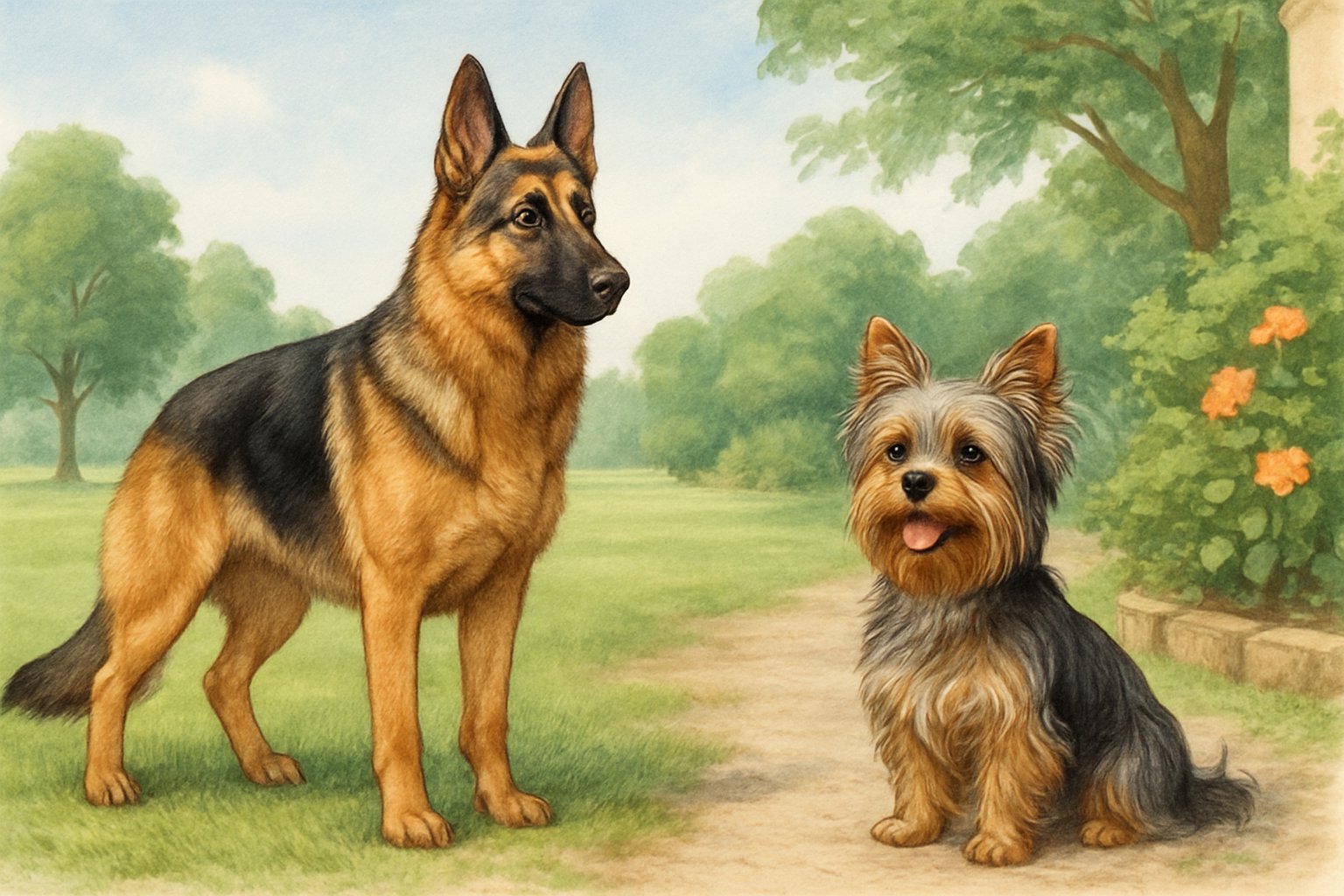
German Shepherds and Yorkshire Terriers bring totally different energy to a home. Their personalities, energy levels, and training needs really shape how they fit into family life.
Trainability and Intelligence
German Shepherds are famous for their smarts and problem-solving. They pick up commands fast and often shine in obedience, police, or service work. If you want a dog that learns quickly, German Shepherds are hard to beat.
Yorkies are clever too, but they’ve got a stubborn streak. Training a Yorkie takes patience and a gentle touch. Positive praise and treats go a long way, but sometimes Yorkies just want to do things their way.
Both breeds need early socialization as puppies. German Shepherds thrive with structure, while Yorkies get bored if things are too predictable. You’ll probably have an easier time training a German Shepherd, especially for complex stuff.
| Breed | Intelligence Level | Ease of Training |
|---|---|---|
| German Shepherd | Very High | Easy |
| Yorkshire Terrier | High | Moderate |
Energy Levels and Playfulness
German Shepherds have tons of energy and need a lot of exercise. They love running, chasing, and doing anything that keeps their minds and bodies busy. If you’re outdoorsy or have a big yard, they’ll be right there with you.
Yorkies are energetic too, but on a smaller scale. Short walks and some indoor play usually keep them happy. They’re playful and love games like fetch or chasing toys around the living room.
Both breeds get bored if they don’t have enough to do. German Shepherds might get restless or noisy, while Yorkies can become yappy. Make sure you’ve got time to play each day.
Compatibility with Children and Families
German Shepherds make great family dogs thanks to their loyalty and protective instincts. With early training, they watch over kids and usually get along with everyone.
Yorkies love people too, but their small size means you need to watch them around young kids. Rough play can hurt a Yorkie, so they’re usually better with older children who know how to handle small dogs.
Socialization is a must for both breeds. German Shepherds often bond with the whole family, while Yorkies sometimes pick a favorite person. No matter the breed, always keep an eye on dogs and kids when they’re together.
Health, Exercise, and Lifespan
German Shepherds and Yorkshire Terriers each come with their own set of health needs, exercise habits, and life expectancies. It’s good to know what you’re in for before bringing one home.
Exercise Requirements
German Shepherds, like Labs and Beagles, need a lot of activity every day. They’re energetic and do best with long walks, play sessions, or even dog sports. Plan for at least 1–2 hours of exercise daily. Without enough to do, German Shepherds might start chewing things or barking too much.
Yorkies, similar to Cocker Spaniels and Poodles, don’t need as much exercise. A couple of short walks and some indoor play are usually plenty. They like being active, but their tiny bodies tire out fast.
If you’re into outdoor adventures, a German Shepherd could be your match. If you prefer low-key strolls or apartment living, a Yorkie’s easier to keep happy.
Common Health Issues
German Shepherds often deal with hip and elbow dysplasia, which causes joint pain and mobility problems. They’re also at risk for degenerative myelopathy and some skin issues. Big breeds like Labs can have similar joint troubles as they get older.
Yorkies are more likely to have dental problems because of their small mouths. They can also face tracheal collapse, luxating patella (wobbly knees), and some eye problems. Other small breeds like Poodles and Cocker Spaniels sometimes have these issues too.
Regular vet visits are important for both breeds. A good diet, grooming, and the right amount of exercise can help prevent or manage many health problems.
Lifespan and Aging
German Shepherds usually live about 9–13 years, which is typical for larger breeds. Like Beagles and Labs, they can start slowing down or getting stiff by age 7 or 8.
Yorkies generally live longer, often reaching 13–16 years. Their small size means they stay playful into old age. That’s pretty common for little breeds, including Poodles and Cocker Spaniels.
As dogs get older, their needs change. Your vet can help you adjust their care and catch age-related issues early.
Suitability for Different Lifestyles
German Shepherds and Yorkshire Terriers fit into different types of homes and routines. Their size, energy, and needs really affect how they do in cities, suburbs, or out in the country.
Urban vs Rural Living
German Shepherds are big, energetic dogs. They really need space to move around, so they’re happiest in homes with a yard or at least easy access to open spaces.
If you keep a German Shepherd in a small city apartment, it’s tough. They can feel boxed in or get restless unless you give them plenty of walks and exercise.
Crowds and loud city noises might stress them out, especially if you leave them alone for hours.
Yorkshire Terriers are tiny and surprisingly adaptable to apartment life. You can scoop them up, carry them in a bag, or walk them on busy sidewalks without much fuss.
They don’t need much room to play indoors, but they still deserve short walks and a bit of activity each day. That said, they might get yappy if they’re always hearing city sounds or other pets nearby.
Here’s a quick comparison of breeds for different settings:
| Breed | Apartment Living | Rural Living | Daily Activity Needs |
|---|---|---|---|
| German Shepherd | Possible, but challenging | Ideal | High |
| Yorkshire Terrier | Excellent | Good | Low to Moderate |
| Dachshund | Good | Good | Moderate |
| Pug | Excellent | Good | Low |
| Pomeranian | Good | Good | Moderate |
| Cavalier King Charles Spaniel | Excellent | Good | Moderate |
Best Choices for First-Time Owners
German Shepherds are smart and loyal. They need firm, consistent training.
Their size and intelligence mean you’ve got to commit to daily exercise and structure. If you’re new to dogs or want a low-maintenance pet, a German Shepherd might feel like a lot to handle.
Yorkshire Terriers are smaller and easier for beginners. They fit into simple routines and travel pretty well.
Grooming can take up some time, but their exercise needs aren’t as demanding as bigger breeds. If you want a small companion and don’t have much space, a Yorkie is often a better choice for first-time owners.
You might also look at the Cavalier King Charles Spaniel. They’re gentle and friendly.
Pugs are another option. They’re sociable and pretty low-key.
These breeds usually work out for beginners thanks to their calm nature and adaptability.
Table key:
- Excellent = Well-suited
- Good = Fits most homes
- Possible, but challenging = Not recommended without experience

